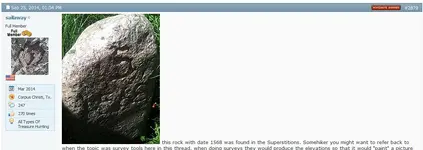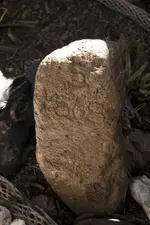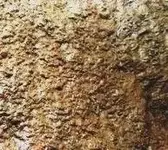sailaway
Hero Member
- Joined
- Mar 2, 2014
- Messages
- 623
- Reaction score
- 816
- Golden Thread
- 0
- Primary Interest:
- All Treasure Hunting
Is it because there is too much information on the Jesuits that we have so much trouble figuring out what they were up to or because there were also many authors who wrote many derogatory articles about them out of ignorance or Biases?Sommervogel has already drawn up a list of 120,000 Jesuit authors and he has restricted himself to those who have ceased from their labors on earth and are now only busy in reading the book of life. Nor do these 120,000 authors merely connote 120,000 books; for some of these writers were most prolific in their publications. The illustrious Gretser, for instance, " the Hammer of Heretics," as he was called, is credited with two hundred and twenty-nine titles of printed works and thirty-nine MSS. which range over the whole field of erudition open to his times: archaeology, numismatics, theology, philology, polemics, liturgy, and so on. Kircher, who died in 1680, wrote about everything. During the time he sojourned in Rome, he issued forty-four folio volumes on subjects that are bewildering in their diversity and originality : hieroglyphics, astronomy, astrology, medico-physics, linguistics, ethnology, horoscopy, and what not else besides. We owe to him the earliest counting-machine, and it was he who perfected the Aeolian harp, the speaking tube, and the microscope.
Famian Strada distinguished himself in 1632 by his " Wars of Flanders," and the work was continued by two of his religious brethren, Dondini and Gallucio. Clavigero's " Ancient History of Mexico," in three quarto volumes, published after the Suppression, is a notable work, as are also his " History of California," and a third on the " Spanish Conquest." legre's three volumes, " History of the Society of Jesus in New Spain" is of great value. Mariana's complete " History of Spain," in twenty-five books, is still recognized as an authority, and it will be of interest to know that as late as 1888 a statue was erected at Talavera, in honor of the same tumultuous writer, who was incarcerated for his book on " Finance." Charlevoix's voluminous histories of New France, of Japan, of Paraguay, and of Santo Domingo are also worthy of consideration. Bancroft frequently refers to him as a valuable historian, and John Gilmary Shea insists that he is too generally esteemed to need commendation.
Molina was the first Jesuit to write a commentary on the theological " Summa " of St. Thomas, and was followed by Cardinal Toletus and those other brilliant Spaniards, Gregory of Valencia, Suarez, Vasquez, and Didacus Ruiz. Suarez, the most prominent among them, is also the foremost theologian the Society of Jesus has produced. His renown is due not only to the fertility and wealth of his literary productions, but also to his clearness, moderation, depth and circumspection. He had a critic, both subtle and severe, in his colleague, Gabriel Vasquez.
It is this period from 1615 to 1664, which, for some undiscoverable reason, is described both by Ranke and Bohmer-Monod as marking the deterioration and decay of the Society. An examination of this indictment is, of course, imperative; and though it must necessarily be somewhat polemical, it may be helpful to a better understanding of the situation and give a more complete knowledge of facts. Ranke begins his attack by throwing discredit on Vitelleschi, describing him as a man of " little learning," adducing as his authority for this assertion a phrase in some Italian writer who says that Vitelleschi was a man di poche lettre ma di santitd. di vita non ordinaria." Now the obvious meaning of this is, not that he was a man of " little learning," but that " he wrote very few letters." As he belonged to an unusally illustrious family of princes, cardinals, and popes; and as he had not only made the full course of studies in the Society, but had taught philosophy and theology for several years and was subsequently appointed to be the Rector of the Collegium Maximum of Naples, which was the Society's house of advanced studies, and as he was, besides, the author of several learned works, it is manifestly ridiculous to class him with the illiterates. As a matter of fact, ^'lutius Vitelleschi was a far better educated man than Leopold von Ranke.
The famous English nun, Mary Ward, appeared in Rome and proposed to establish a religious congregation which would do for women in their own sphere what the Jesuits were
doing for men, refered to as "Jesuitesses." They began their work, and were approved by the Holy See in 1639. At first, they were known in Rome as " The English Ladies." In Ireland and America they are " The Loretto Nuns " Father Vitelleschi encouraged them.
First to furnish the learned world with information about Mexico and California as far as the Rio Grande, travelled by Kino (1644-1711), Sedlmayer (1703-79) and Baegert (1717-77)
State of the Society — The Seven Years War — Political Changes — Rulers of Spain. Portugal, Naples, France and Austria — Febronius — Sentiments of the Hierarchy — Popes Benedict XIV; Clement XIII; Clement XIV. Just before its suppression, the Society had about 23,000 members. It was divided into forty-two provinces in which there were 24 houses of professed fathers, 669 colleges, 61 novitiates, 335 residences and 273 mission stations. Taking this grand total in detail, there were in Italy 3,622 Jesuits, about onehalf of whom were priests. They possessed 178
houses. The provinces of Spain had 2,943 members (1,342 priests) and 158 houses; Portugal, 861 members (384 priests), 49 houses; France, 3,350 members (1,763 priests), 158 houses; Germany, 5,340 members (2,558 priests), 307 houses; Poland, 2,359 members; Flemish Belgium, 542 members (232 priests), 30 houses; French Belgian, 471 members (266 priests), 25 houses; England, 274 members; and Ireland, 28. Their missions were in all parts of the world. In Hindostan, de Nobili, and de Britto's work was being carried on; in Madura, there were forty-seven missionaries. The establishments in Persia extended to Ispahan and counted 400,000 Catholics. Syria, the Levant and the Maronites were also being looked after. Although Christianity had been crushed as early as 1644, the name of the province of Japan was preserved, and in 1760 it counted fifty- seven members. There were fifty-four Portuguese Fathers attached to China at the time of the Suppression, and an independent French mission had been organized at Pekin with twenty-three members mostly priests. In South America, the whole territory had been divided into missions, and there were 445 Jesuits in Brazil, with 146 in the vice- province of Maranhao. The Paraguay province contained 564 members of whom 385 were priests; they had 113,716 Indians in their care. In Mexico, which included Lower California, there were 572 Jesuits, who were devoting themselves to 122,000 Indians. New Granada had 193 missionaries; Chili had 242; Peru, 526; and Ecuador, 209.
In the United States, they were very few, on account of political conditions. At the time of the Suppression, they numbered only nine, two of whom Robert Molyneux and John Bolton survived until the complete restoration of the Society. The French had missions in Guiana, Hayti and Martinique; and in Canada, the work inaugurated by Brebeuf among the Hurons, was kept up among the Iroquois, Algonquins, Abenakis, Crees, Ottawas, Miamis and other tribes in Illinois, Alabama and Lower Mississippi. At the time of the Suppression there were fifty-five Jesuits in Canada and Louisiana.
Full text of "The Jesuits, 1534-1921; a history of the Society of Jesus from its foundation to the present time"
Last edited:









